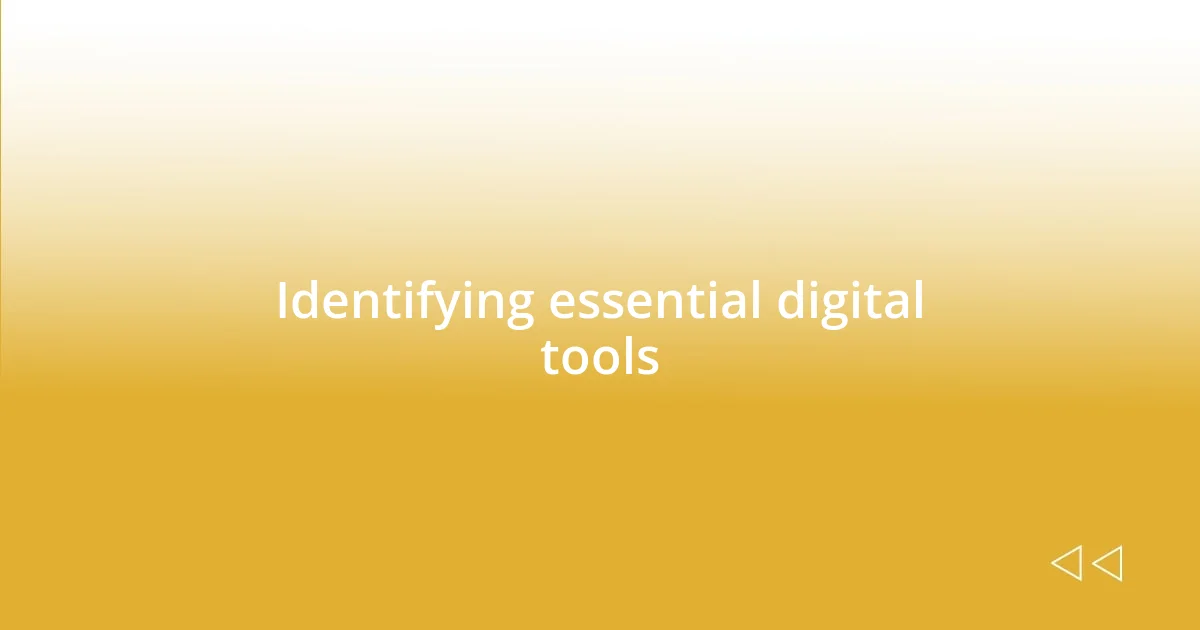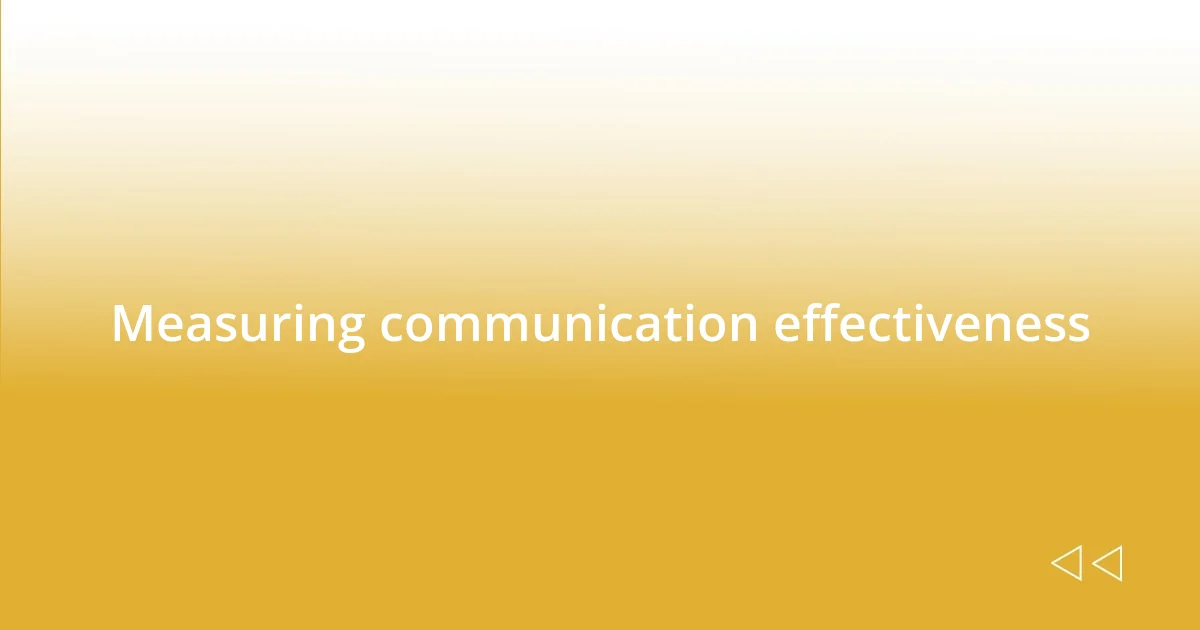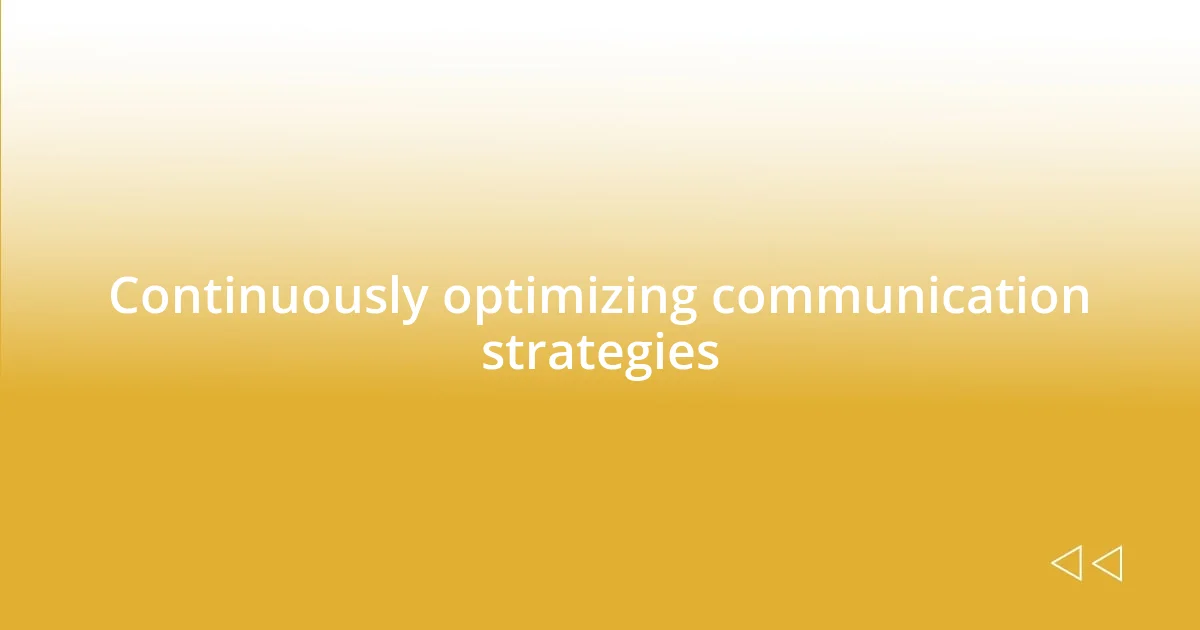Key takeaways:
- Establishing clear communication guidelines and norms can significantly reduce confusion and enhance team interactions.
- Utilizing the right digital tools, such as messaging platforms and project management software, helps streamline communication and fosters accountability within the team.
- Regularly measuring communication effectiveness through feedback and surveys allows for continuous optimization and improvement of strategies to enhance team collaboration.

Understanding communication challenges
Communication challenges can often stem from misunderstandings or a lack of clarity in messages. I remember a project where team members interpreted my instructions differently, leading to confusion and delays. Isn’t it frustrating when everyone is working hard but feels misaligned?
Another layer to these challenges is the emotional aspect—how tone and body language often get lost in digital conversations. I once sent a quick message that I thought was straightforward, but a colleague felt it was curt. It made me realize that without non-verbal cues, the intent behind our words can easily be misconstrued. Have you ever faced similar situations where your words were taken out of context?
Lastly, time zones and varying work styles can create barriers that feel insurmountable. During one international project, coordinating meetings was like a puzzle, with people staying up late or waking too early. How do we bridge those gaps? Turning to technology helped immensely, but the real challenge lies in fostering a culture of understanding and flexibility among team members.

Identifying essential digital tools
Identifying the right digital tools is crucial for enhancing communication in any team. From my experience, tools like Slack or Microsoft Teams can significantly streamline conversations. I remember a time when our team used email for everything, causing important messages to get lost in overflowing inboxes. Embracing a messaging platform made our communication flow much smoother, and almost instantly, we saw quicker responses and happier team members.
Beyond messaging, project management tools like Trello or Asana can optimize task collaboration. Initially, I found it challenging to keep track of who was doing what on our projects. After using Trello for a few months, it became my go-to for visualizing task progress—it turned chaos into clarity. I can’t tell you how many times I felt a sigh of relief seeing all tasks lined up, allowing us to celebrate small wins together.
Lastly, video conferencing platforms like Zoom have become indispensable for face-to-face interactions, even from a distance. I vividly recall a virtual brainstorming session where sharing screens turned ideas into tangible outcomes. The energy and excitement felt almost palpable, as if we were all in the same room. Isn’t it amazing how technology can foster those moments that fuel creativity and collaboration?
| Tool | Purpose |
|---|---|
| Slack | Instant messaging and team collaboration |
| Trello | Project management and task tracking |
| Zoom | Video conferencing for virtual meetings |

Choosing the right communication platform
Choosing the right communication platform can feel overwhelming, but I’ve learned that it’s essential to match tools with your team’s specific needs. For example, I once worked with a group that struggled to adopt a single tool because everyone had their preferences. This diversity created silos, and I realized that engaging the team in selecting platforms was crucial. It wasn’t just about functionality; their buy-in made all the difference, enhancing collaboration and reducing resistance.
To make your selection process easier, consider these key factors:
- Team Size and Structure: Larger teams might need more complex tools for organization, while smaller groups could thrive with simpler options.
- Nature of Work: If you frequently share files or work on projects, a platform with robust file-sharing capabilities is a must.
- Integration with Other Tools: Fitting the communication platform into your existing workflow can save time and effort.
- User Experience: Ensure the platform is intuitive and enjoyable to use; otherwise, it might deter engagement.
- Feedback Mechanism: Incorporate a way for team members to voice their thoughts on the tools. Their insights can lead to better adaptability and effectiveness.
Having navigated the treacherous waters of digital tools myself, I can confidently say that understanding the team’s dynamics, preferences, and challenges is what makes any platform truly effective. It’s not just about adopting a tool; it’s about fostering a culture of communication that feels inclusive and empowering.

Implementing tools for team collaboration
Implementing digital tools for team collaboration transformed the way my team interacts daily. I vividly remember transitioning from endless email threads to a shared platform like Microsoft Teams. Initially, I was skeptical—would it really make a difference? The moment we started tagging each other in conversations and sharing files in real-time, I felt the weight lift off my shoulders. Communication became instantaneous, and it allowed us to tackle issues as they arose, rather than letting them fester.
There was also the matter of integrating tools effectively into our existing routines. I found that when we began using Asana, it wasn’t just a project management switch; it sparked a cultural shift within the team. Each member began to take ownership of their tasks, and I noticed a newfound sense of accountability. I often sat back, astonished at the level of engagement during our weekly updates. Who would have thought that a simple tool could transform passive participation into active involvement?
Moreover, it’s crucial to keep the dialogue open about these tools. After all, my experience has taught me that asking for feedback often reveals underlying issues—what’s working, and what isn’t? There was a time when we used a tool that seemed perfect on paper, but team members felt overwhelmed by its complexity. After incorporating their suggestions, we switched to a more user-friendly option that encouraged participation instead of frustration. Isn’t it incredible how embracing feedback can unlock your team’s full potential?

Setting guidelines for effective usage
Setting clear guidelines for the effective use of digital communication tools has been a game-changer for me and my team. When we first adopted Slack, I noticed that our conversations could easily spiral into chaos. To combat this, I introduced a set of communication norms, such as using threads for specific topics and establishing designated channels for particular projects. It was fascinating to see how these simple rules helped streamline discussions, reducing confusion and making it easier for everyone to find relevant information. Have you ever felt lost in a sea of messages? I have, and that’s exactly why setting those boundaries is so essential.
One important aspect of these guidelines is the frequency and timing of communication. I learned this the hard way: during a particularly stressful project, my team was inundated with messages around the clock. While it felt necessary at the time, I quickly realized burnout was creeping in. By establishing “quiet hours” and encouraging asynchronous communication, I noticed a significant shift in morale. It allowed my team to recharge, knowing they wouldn’t have to respond immediately after hours. Don’t you think a balance between availability and personal time is vital for maintaining productivity?
Lastly, I’ve found that providing training and resources on how to use these tools effectively fosters confidence and engagement among team members. I remember when we first rolled out a new video conferencing tool; many people felt apprehensive about using it. To ease their concerns, I organized casual training sessions and created a shared document filled with tips and tricks. Seeing my colleagues become comfortable with the technology was immensely rewarding. Isn’t it uplifting when people feel empowered to communicate without barriers? It’s these little victories that ultimately make a significant difference in how we connect and collaborate.

Measuring communication effectiveness
Measuring communication effectiveness is vital for ensuring that the digital tools I’ve introduced are truly enhancing team interactions. I remember one particular week when we conducted our first survey to gauge how our new platforms were working for everyone. Seeing the diverse feedback—some praising the ease of use while others pointed out remaining challenges—was eye-opening. It reinforced my belief that understanding communication’s impact isn’t just about numbers; it’s about listening to the voices behind those numbers.
I also implemented follow-up discussions after key projects to analyze team dynamics and communication flow. During one such debrief, a colleague shared that while they appreciated the rapid exchange of ideas, they sometimes felt overwhelmed by the volume of messages. Hearing this made me reflect: how can we balance speed with clarity? It was a pivotal moment that led us to reassess how we initiate discussions and prioritize messages. By ensuring everyone felt valued and heard, we tightened our collective focus on shared goals.
Another method I explored was tracking response times and engagement levels in our communication tools. At one point, I noticed that certain projects had slower engagement rates, raising my eyebrows—what was going on? Diving into this data, I discovered that unclear expectations or information overload were often at play. This prompted me to create clearer project briefs and set more deliberate check-in points. Hasn’t it been fascinating to turn numbers into actionable insights? Each lesson learned from this process truly enhanced our communication strategy and fostered collaboration.

Continuously optimizing communication strategies
Continuously optimizing communication strategies is about being adaptable and responsive to the needs of the team. For instance, I remember when we decided to shift from weekly team meetings to a more flexible check-in system. At first, I was nervous—would people feel disconnected? Surprisingly, it led to higher engagement levels. By allowing everyone to share updates when it suited them, not only did we improve efficiency, but team members expressed more satisfaction in their contributions. Have you ever experienced a similar shift that positively impacted your team dynamics?
Another key aspect I’ve found vital is the regular review of our communication tools. One time, while analyzing our use of a project management app, I noticed a significant uptick in frustration from team members. It turned out that several features weren’t intuitive, leading to unnecessary confusion. Encouraging open dialogue about which tools are working and which aren’t helped us replace what was ineffective and streamline our workflow dramatically. It’s amazing how quickly things can change when you listen to the team, isn’t it?
Lastly, I can’t stress enough the importance of celebrating small wins. After implementing changes to our communication strategy, I asked the team to share their successes, no matter how minor. I was thrilled to see a strong response, with team members highlighting improved collaboration and creativity. This not only boosted morale but also reinforced the positive impact of our ongoing efforts. When was the last time you recognized a team’s effort? I’ve learned that cultivating an environment where people feel acknowledged lays a solid foundation for continuous improvement in communication.















